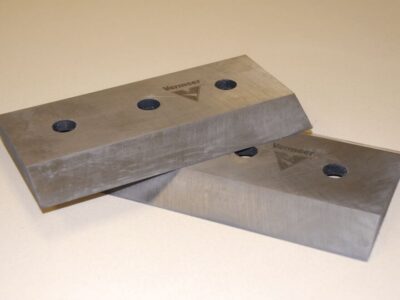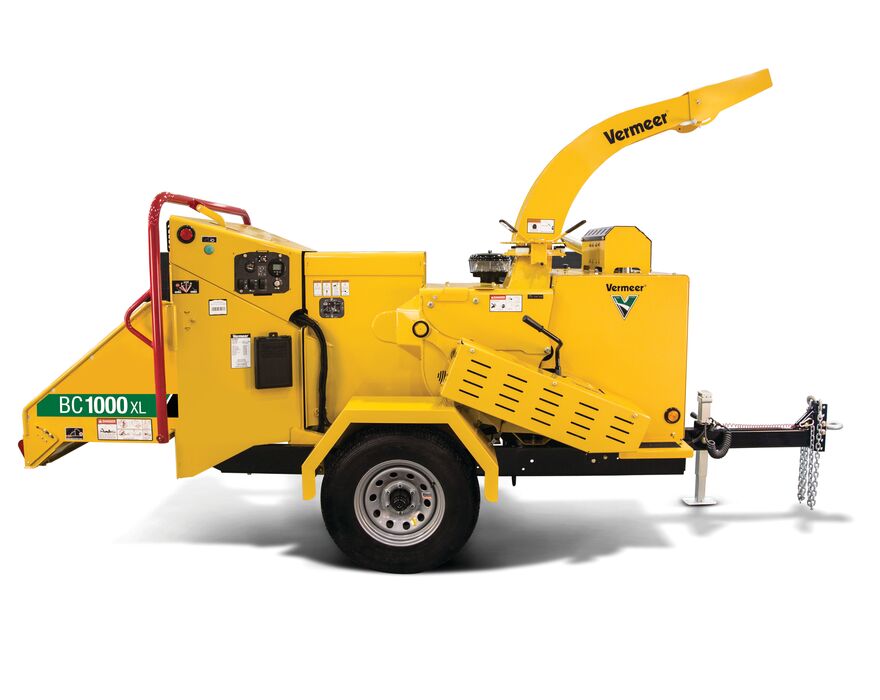Brush chipper knives are the hardest working components on your machine. These knives cut and size the chips, but all that work can make them dull over time. Sharp chipper knives allow for a clean cut and produce a smaller and consistent chip which can be thrown farther — which helps crews fill the back of the truck and maximize usage of their space. Despite their importance, sharp brush chipper knives are not always a top priority for operators.
As brush chipper knives dull, wood chip quality becomes compromised and inconsistent in size. Chips may appear stringy, ripped or torn. When this happens, the brush chipper is working harder than usual, burning more fuel and increasing processing time. The higher workloads can accelerate belt, bearing, and clutch wear and create vibration during operation. Unnecessarily harsh vibration can lead to preventable component failure for the switch, relay, solenoid, cover, latch, lights and other elements.
However, regular maintenance and a diligent routine can help minimize these issues before they begin. Here’s what crews can do to best prevent challenges.
Monitor brush chipper knife condition
Brush chipper knives should be checked daily to maximize performance.
“If your chip size is consistent in the main part of the log, that means your knives are sharp,” explained Cole Chesnut, Vermeer applications specialist. “But if your brush chipper is producing stringier material, it’s an inconsistent size or your machine is getting plugged, it can mean your knives are too dull.”
Knife edge wear varies depending on what material is being processed. Hardwoods like red oak and fibrous materials like palm trees can wear down knives quickly, whereas softwoods like fir and western cedar cause less wear on the brush chipper knives. A good rule of thumb is to replace the knives after 50 hours of use. However, they will need earlier replacement if they become dull. Monitoring what goes into the chipper can also help extend chipper knife life. Avoid allowing materials like sand and metal debris through, as they will shorten knives’ useful life.
It is beneficial to keep track of the runtime for your chipper knives so you can determine if you are getting enough time out of them, according to Vermeer product specialists. Many customers keep a log for each machine in service to record not only the number of hours the knives are in use but also the materials being cut and environmental conditions.
Sharpen or replace chipper knives?
You have two options to deal with dull brush chipper knives: sharpen or replace. Replacing brush chipper knives with new ones saves time compared to sharpening your existing set. Install the new set and the machine is immediately ready to get back to work. Sharpening knives is a more time-intensive process, though chipper knives can be sharpened several times for significant cost savings.
Reach out to your local Vermeer dealer to learn about sharpening knives or purchase a Vermeer Stay Sharp kit. The kit includes everything you need to replace the knives, including the hardware, bolts, oil for the bolt threads, and information on installation and care.
Brush chipper knives need to be sharpened to the correct 30-degree angle and correctly installed to prevent over-stressing the retaining bolts. Using a hand-sharpening tool, bench grinder or local general machine shop to sharpen chipper knives can create inconsistencies on the cutting edge. To optimize brush chipper performance, tolerance must be maintained to within five- and ten-thousands of an inch. This requires precision sharpening equipment that maintains exact tolerances.
Running dull knives too long could make it impossible to re-sharpen them. It could also result in chipping, denting or breaking of the knives.
Proper chipper knife installation is essential
It’s best practice to replace brush chipper knives in sets of two to maintain proper drum balance. If the knives aren’t balanced, bearings may fail prematurely.
High-quality chipper knives will remain sharp longer. Vermeer brush chipper knives use high-grade steel and a dual-tempered heat-treatment process, making the steel hard enough to hold an edge and strong enough to withstand tough material. Using Vermeer replacement chipper knives takes the guesswork out of maintenance. The wearable components on brush chippers have been engineered to precise specifications and tolerances.
When replacing brush chipper knives, important steps must be followed for optimal performance. The anvil condition and clearance of the knives are critical. As the knives are sharpened, the clearance distance to the anvil must be adjusted to maintain an accurate gap. You are changing the gap between the shear bar and the chipper knife when material is removed from the knife during the sharpening process. The spacing between the shear bar and the chipper knife must readjusted to the specification in the owner’s manual to achieve optimal performance. Refer to your machine’s maintenance manual for safety messages and further instructions.
Always replace the existing mounting bolts with new Vermeer-approved bolts when installing new or sharpened knives. Reuse of the bolts decreases their clamping force after retorquing. Tightening knife retention bolts to the correct torque is critical when installing new or sharpened brush chipper knives.
Having an extra supply of new brush chipper knives on hand can keep crews working even when one set needs to be unexpectedly sharpened. And if you keep multiple sets of brush chipper knives in inventory, you can have several dull knives sharpened at the same time for added efficiency.
Have questions? Contact your local Vermeer dealer.
Vermeer Corporation reserves the right to make changes in engineering, design and specifications; add improvements; or discontinue manufacturing at any time without notice or obligation. Equipment shown is for illustrative purposes only and may display optional accessories or components specific to their global region.
Please contact your local Vermeer dealer for more information on machine specifications. Vermeer and the Vermeer logo are trademarks of Vermeer Manufacturing Company in the U.S. and/or other countries.
© 2024 Vermeer Corporation. All Rights Reserved.

